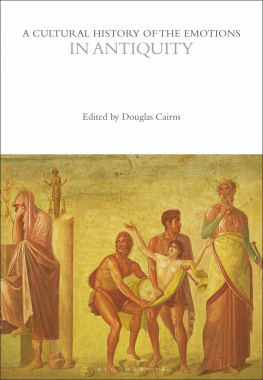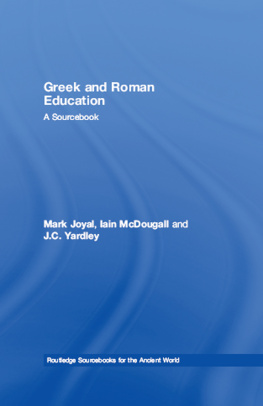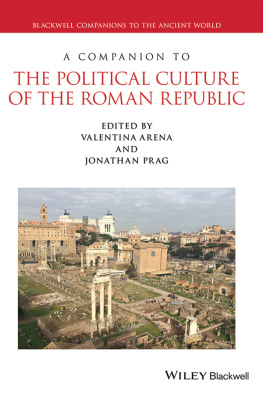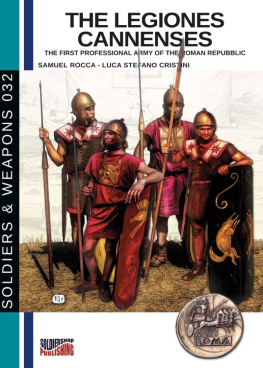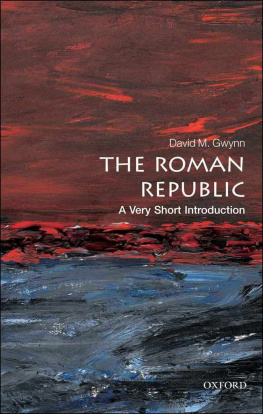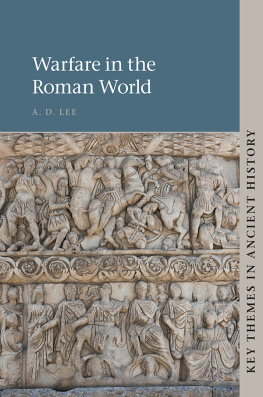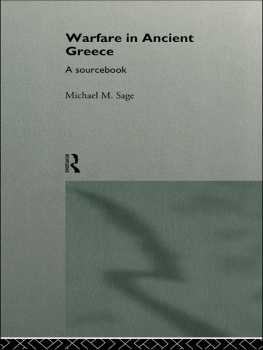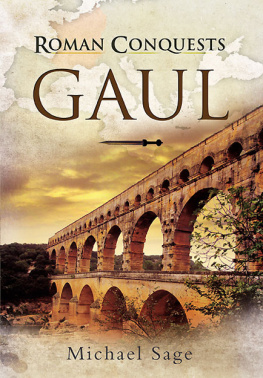THE REPUBLICAN ROMAN ARMY: A SOURCEBOOK
The Republican Roman Army assembles a wide range of source material and introduces the latest scholarship on the evolution of the Roman army and the Roman experience of war. The author has carefully selected and translated key texts, many of them not previously available in English, and provided them with comprehensive commentaries and essays.
This wide-ranging survey of documents recreates the social and historical framework in which ancient Roman warfare took place from the archaic and Servian period through to the Late Republic. The topics addressed extend beyond the conventional questions of army mechanics such as strategy and tactics, and explore questions such as the armys influence on Roman society and its economy.
Complete with notes, index and bibliography, The Republican Roman Army provides students of ancient and military history with an unprecedented survey of relevant materials.
Michael M. Sage has been a member of the faculty of Classics at the University of Cincinnati since 1975.
THE REPUBLICAN
ROMAN ARMY
A Sourcebook
Michael M. Sage

First published 2008
by Routledge
270 Madison Ave, New York NY 10016
Simultaneously published in the UK
by Routledge
Transferred to Digital Printing 2010
2 Park Square, Milton Park, Abingdon, Oxon, OX14 4RN
Routledge is an imprint of the Taylor & Francis Group,
an informa business
2008 Michael M. Sage
All rights reserved. No part of this book may be reprinted or
reproduced or utilised in any form or by any electronic,
mechanical, or other means, now known or hereafter
invented, including photocopying and recording, or in any
information storage or retrieval system, without permission in
writing from the publishers.
British Library Cataloguing in Publication Data
A catalogue record for this book is available from the British Library
Library of Congress Cataloging in Publication Data
A catalog record for this book has been requested
ISBN 10: 0415178797 (hbk)
ISBN 10: 0415178800 (pbk)
ISBN 10: 0203926617 (ebk)
ISBN 13: 9780415178792 (hbk)
ISBN 13: 9780415178808 (pbk)
ISBN 13: 9780203926611 (ebk)
CONTENTS
Abbreviations
AC | Antiquit Classique |
BAR | British Archaeological Reports |
CAH | Cambridge Ancient History |
ClAnt | Classical Antiquity |
CQ | Classical Quarterly |
JHS | Journal of Hellenic Studies |
JRS | Journal of Roman Studies |
PBSR | Papers of the British School at Rome |
TAPhA | Transactions and Proceedings of the American Philological Association |
Introduction
The last three decades have seen a renewed interest in both Greek and Roman military history. The focus of recent studies has shifted from the traditional areas of tactics, strategy and battle analysis to a greater emphasis on the relationships of armies to the societies that produced them and to recreating the experience of battle in the ancient world.
In Republican military studies the traditional areas have long received attention, owing to the well-recognized connection between changes in the Roman army and the political fortunes of the Republic, but they have recently been approached from a far wider perspective than had earlier been the case and new methods of analysis have been brought to bear.
The second line of analysis owes it origins to the epoch-making study by John Keegan, The Face of Battle (New York, 1978), which attempted to recreate the experience of battle over the course of five hundred years. The detailed descriptions of the battles of the Second Punic War and of some of the battles that marked Romes expansion into the eastern Mediterranean as well as Caesars accounts of his Gallic campaign and the Civil War provide material for such a reconstruction that has no parallel in earlier or later Roman history.
This sourcebook is an attempt to bring together relevant ancient testimony on various aspects of the Roman army and its relation to Roman society to the end of the Republic. Commentary has been added to place these passages in context and to provide some of the insights offered by recent scholarship on these problems.
The Sources
Any attempt to trace the history of the Roman army during the Republic faces formidable problems. This is especially true of the written sources that are fundamental to tracing the evolution of Roman tactics and strategy. The major historical sources for the earliest period, Livy and Dionysius of Halicarnassus, both writing towards the end of the first century, anachronistically project the army of the third and second centuries back into the Regal period and the first centuries of the Republic. This may in part be due to the fact that the birth of historical writing at Rome took place about 200, precisely in the period. Although historical writing focused on politics and military affairs, it tended to avoid technical details of army organization and structure. There are occasional exceptions to this indifference but they mostly concern modifications to weapons associated with major political and military figures such as the changes in the javelin or pilum ascribed to Marius and Caesar. However, they seem to be the product of interest less in these details than in the figures themselves. It is significant that none of the major changes in army organization have found their way into the historical record. Although both Livys and Dionysius histories contain valuable digressions such as their accounts of the Servian army (see pp. 19ff.) they make no attempt to integrate them into their narratives. The one exception to this is the account of the Roman army by the mid-second-century Greek historian Polybius. Unlike Livy and Dionysius he had personal experience of warfare and an interest in its technical side as reflected in his comparison of Roman tactical formations with the Greek infantry phalanx. Polybius main aim was to explain the success of Romes army to a Greek audience and in doing so he gave the most detailed account of the Roman army of the mid-second century that we possess. It is fundamental to any description of the Roman army of this period.
The most significant contribution to understanding the evolution of tactics and organization is provided by the antiquarian tradition which arose in the second century. The most important author is M. Terentius Varro, who wrote in the middle of the first century. Unfortunately, much of this work has been lost and survives only in fragments quoted in later authors. Antiquarian writers were unconstrained by the rules of historical writing that discouraged the use of technical terms and allowed only limited treatment of institutional development. These were, in fact, the very questions that preoccupied antiquarian writers. It is likely that an antiquarian writer is the source of the digressions in Cicero, Livy and Dionysius on the Servian army. The fragmentary nature of the extant material and its often narrow focus prevent the antiquarian tradition from offering a coherent account of army development, but it is vital to the construction of such an account.
Military manuals offer little help in reconstructing Roman military history. The earliest known work by Cato the Elder (
Next page

